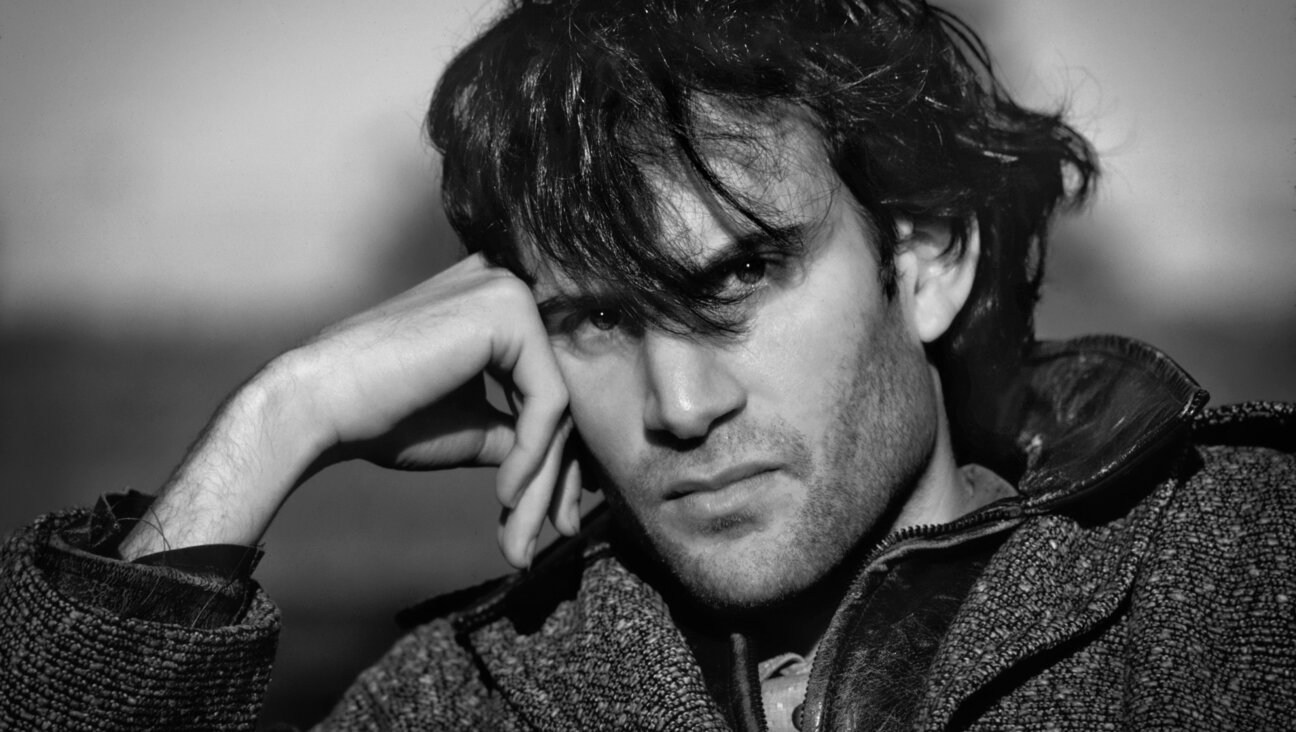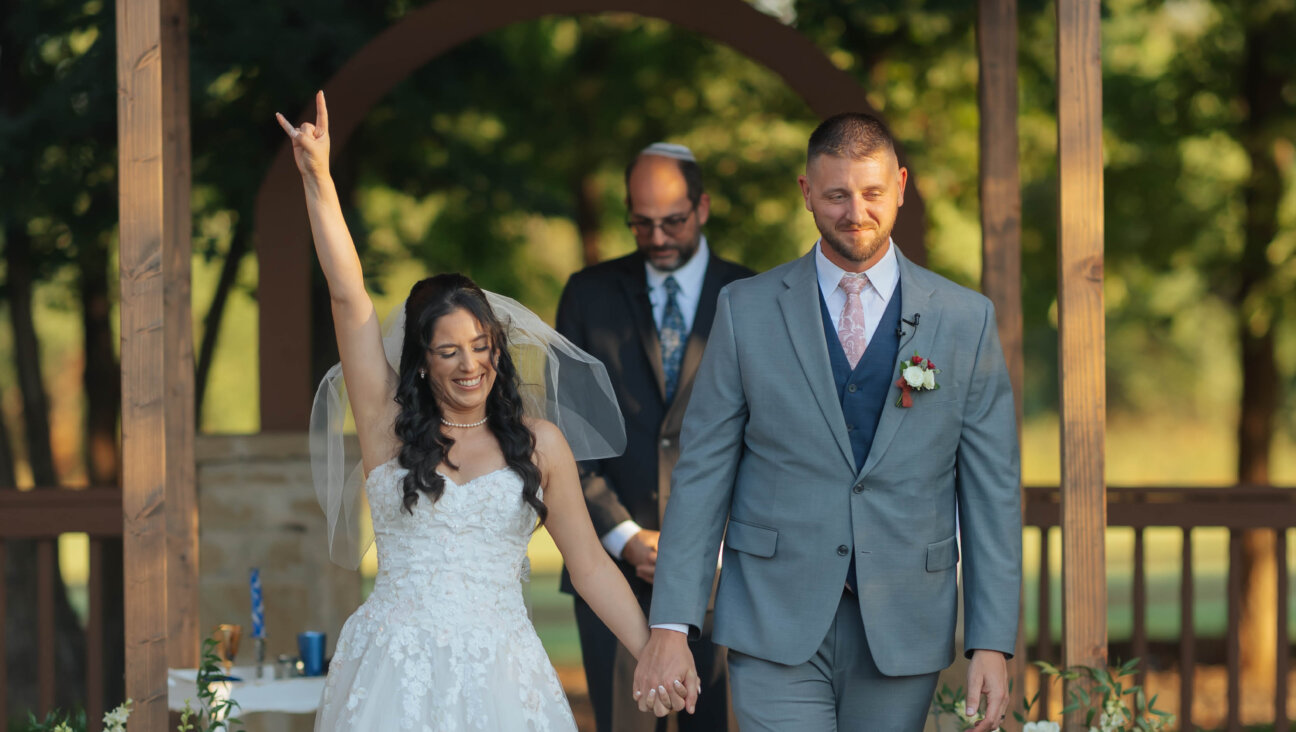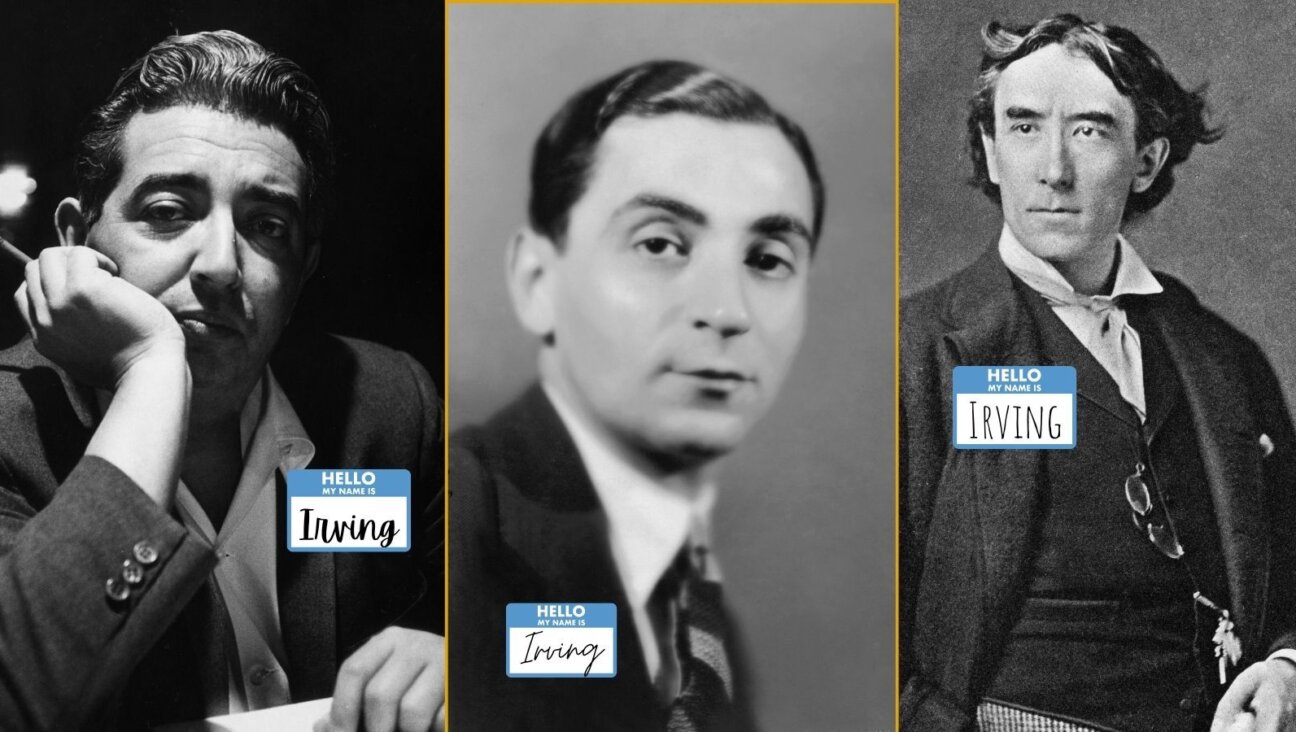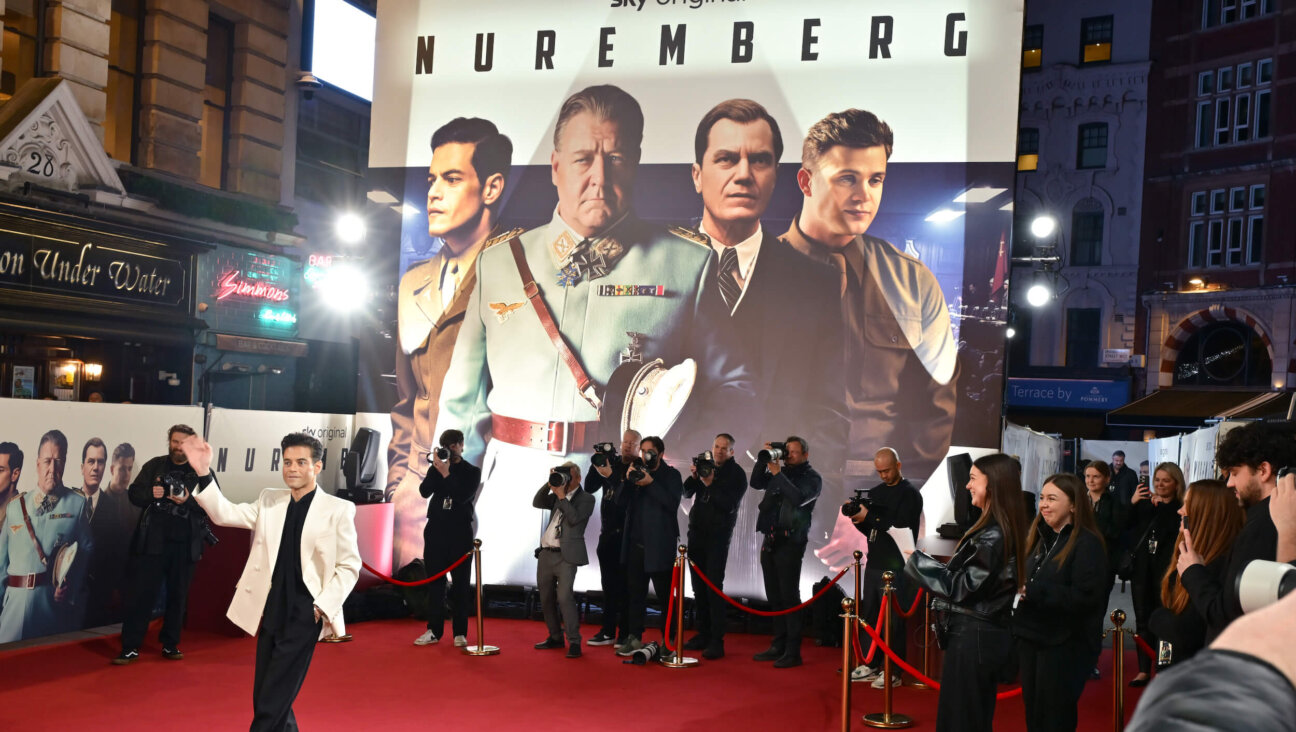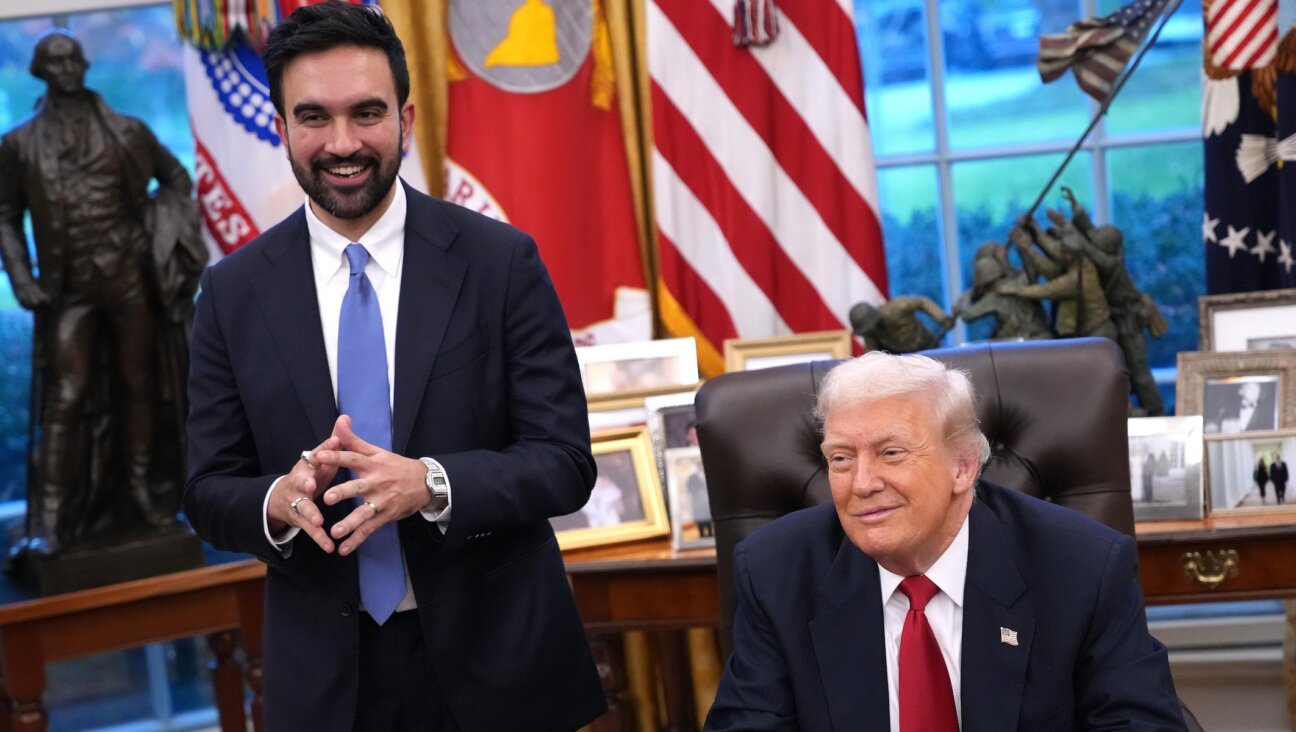Meet Sam Adams — Humphrey Bogart’s Assistant and I.B. Singer’s Dealmaker

Graphic by Angelie Zaslavsky
I met retired Hollywood film and literary agent Sam Adams while I was on a research trip for my forthcoming book. When I introduced myself, he was reading a dog-eared copy of perhaps the greatest of true Antarctic tales, Apsley Cherry-Garrard’s “The Worst Journey in the World.”
Sam, now just shy of his 90th birthday, was then 88, full of energy, and very funny. Although he adored his wife, a harpsichordist he married after a dozen years as a widower, she simply didn’t share his passion for traveling to the coldest spot on Earth. Sam was solo for our journey, the oldest passenger on a rather rough expedition route, and one of the trio of Jews (including me) aboard the ship.
The following oral history is taken from many conversations with Sam that took place at sea as we dodged the great tabular icebergs of the Southern Ocean.

In Antarctica: Laurie Gwen Shapiro with Sam Adams (at right). Image by Courtesy of Laurie Gwen Shapiro
SAM ADAMS:
I was born in Chicago on April 4, 1927. Adams may be an all-American name, but all I know from before my time is that my surname was supposedly biblical in origin, after Adam, and my grandfather was keeper of the city seal of Chicago.
When I was still a kid in Chicago, one of my mother’s many brothers, Joseph Schnitzer, was vice president in charge of production for RKO Studios. Uncle Joe employed all his relatives, and my dad was in a good job at RKO as their Western division film sales manager. Our life was not bad until the 1929 stock market crash, but I don’t remember that time much, except for little flashes of a trip to the Caribbean when I was three; for me, the journey was the start of a lifelong love affair with the sea. When the Depression worsened, Uncle Joe was called in by RKO’s board of directors, and promised he would end his nepotistic ways. He fired his relations, including my father. After he did this, Uncle Joe was reelected to his former position with a sound vote of confidence. But Uncle Joe resigned from RKO even after he had been reelected.
RKO had a rough ride financially, but somehow managed to produce distinguished fare including the nine Fred and Ginger pictures, “The Hunchback of Notre Dame” and later on I remember Paul Henried and Eleanor Parker in “Of Human Bondage.” That was later, when I was a messenger at Warner Brothers, maybe I remember that one because years later I represented Paul as a director. They also managed to produce “King Kong” and “Citizen Kane.”
At the end of his career, my father managed the Clark Theater in Chicago. My mother was born in Pittsburgh, a good-looking woman, but to describe her as difficult is an understatement. But I loved her; she was my mother, however flawed. I didn’t like my father much. In today’s world, I would have been considered an abused child. I got the belt many times, but that was very common back them. Every day she worked and she left me unsupervised and gave me 25 cents for lunch. I was free to roam, and spent most of the summer of 1934 at the Chicago’s World’s Fair (also known as the “Century of Progress” exhibition) by myself on a pass, at seven years old. Admiral Byrd’s 1928 Antarctica boat was exhibited at the fair. My heroes were Shackleton and Scott, but it was Byrd who got Antarctica on most Americans’ radar.

World’s Fair: As a boy in Chicago, Sam Adams attended the Century of Progress Exposition. Image by Getty Images
My parents divorced back in Chicago. Later in 1934, when I was still seven, my mother moved with me to Los Angeles so she could become Uncle Joe’s secretary. My father came to live in Los Angeles for a short time after my mother moved us there but he left, and I only saw him twice thereafter. In my mind he wasn’t much of a father anyway. I idolized my Uncle Joe.
•
When we first arrived in California, Mom and I lived in a small apartment around the corner from Warner Brothers’s Beverly Theater. I was still my own babysitter, and occasionally I’d snag a good seat in the public bleachers to watch the premieres. Someone like Bette Davis would pop out of limousine, then Humphrey Bogart.
I was on the bleachers for “Confessions of a Nazi Spy” starring Edward G. Robinson and Francis Lederer; it was the first anti-Nazi film made by a studio prior to World War II. Before that film, industry heads were fearful they would lose German distribution money and tried to remain neutral.
Everyone would go bananas at the sight of the stars, of course, but when the executives came out, you’d hear: “Who is it?” “Nobodies!” Nobodies like Jack Warner, Louis B. Mayer and Harry Warner. I knew who they were. I had even met Harry Warner in person because Uncle Joe was his best friend. On a very good Sunday night, we might head with my uncle to Harry’s ranch and see a movie.
When I was still in elementary school, the summer of 1934, Uncle Joe bought Western Costumes, which was the largest costume company in the world, around since the earliest silent films; later on they made the ruby slippers for “The Wizard of Oz.”
Hollywood worked six days a week back then, and Western Costume was my synagogue on Saturdays. I tried on costumes — though I don’t think my uncle knew about it — and there was a gunroom filled with flintlock rifles from the 18th century. Heaven.
Celebrities didn’t pay mind to a small boy. I’d see them in dressing room trying on costumes. Sometimes I’d get to sit with the switchboard operator connecting wires. The switchboard gal liked me and she let me sit on her lap and use the loud speaker to page celebrities. Once I paged Victor McLaglen [McLaglen won the Academy Award for Best Actor for “The Informer” in 1936] and he started to kid me that I was a mighty young hire.
I entered Beverly Hills High School in the fall of 1940. My best friend wrote a play about Hitler my sophomore year, and I was cast in the role of Hitler. Because of my family connection to Western Costumes my uncle gave me the exact Hitler uniform Charlie Chaplin wore in “The Great Dictator.” That got me some notoriety in school.
Western Costumes became unionized. My uncle was not anti-labor. He was a liberal Democrat, and was well liked by his employees. Yet he wanted to sell the company because he could not meet the payroll. He approached the studios and said, “Can you guys get along without Western?” All of the studios panicked. My uncle said, “So buy me out or I will auction!” That’s how he sold to the big five major studios who formed a co-op.
My sophomore summer, 1943, I got myself hired as a mechanic at Douglas Aircraft in Santa Monica for $35 a week. That was an amazing salary for a kid. I was a template maker, but I never made one that passed inspection. I found the job rather humdrum. I thought maybe I should become a photographer, more action. When I returned to school in the fall I volunteered on the school paper, the Beverly Hills Highlights. One popular older classmate heavily involved with extracurricular clubs was Dick Sherman, who you might know from the Sherman Brothers, half of the famous songwriting team [“Mary Poppins,” “Chitty Chitty Bang Bang”]. The pianist and conductor Andre Previn was a year behind. The guy I was closest to however was Lynn Stalmaster, who went on to be a major casting director; happily he is still alive too and last year got an honorary Oscar for casting. Back then Lynn and I were inseparable.
Mostly everyone associated me with my camera. The yearbook was filled with my photos of football games and concerts.
One of my big memories of high school is that my Uncle Joe died in 1944 at the age of 57. And my mother went to work as a secretary for another one of her brothers.
•

In the Sierra Nevadas: Sam Adams hikes with a backpack he borrowed from the director Sam Peckinpah. Image by Courtesy of Sam Adams
Every Thursday, Beverly Hills High had an assembly of their entire student body auditorium. One day they said there would be a special surprise, but as class photographer I had the inside track: The surprise was Ronald Reagan, who had left acting to be an army captain and was volunteering to give local high school kids a patriotic speech. This was the era of the bobbysoxers, and my school was full of them. The girls in my class screamed upon Captain Reagan’s arrival. Oddly, the attention infuriated him. He thought they were disrespectful to him. Reagan stomped off. Behind the school, there was an alleyway that led to guest parking lot. I was determined to get my newspaper photo. I stood in the alley blocking his way, hoping to get Reagan to smile for me, but he hadn’t calmed down, and leaned out of the window upbraiding me, shaking his fist, and that was the photo that ran in Highlights. I came to the conclusion he wasn’t really the nice guy everyone thought he was back then, even though he was a Democrat in those days. I saw him on set for “Voice of the Turtle” based on a Broadway play. Truthfully, more than a bit mean.

No Mr. Nice Guy: As a high school photographer, Sam Adams encountered Ronald Reagan. He was unimpressed. Image by Getty Images
I should explain how I saw Reagan on a set. After that parking lot incident, I miraculously landed a coveted messenger boy spot at Warner Brothers during my last two years of school, a gig that I held onto even after school was done and after a stint in basic training. I almost ran to work on the first day, and I bumped straight into Lauren Bacall walking onto the sound stage, and she smiled at me after I apologized.
I was drafted two weeks after my high school graduation. I was still in basic training on August 14, or V-J Day, when Truman announced Japan’s unconditional surrender. I hated the Army, especially as I’d left my high school sweetheart behind.
I saw 18 months of active duty in the Army. What I didn’t see was combat duty. I was in radio operator’s school at Ft. Riley, Kansas. I went right back into my Warner messenger job while I figured out what I wanted to do. I originally wanted to be a stage designer but felt there was not really a job there — about six people made a good living doing that, so I decided to be a cameraman and make some money. I was told I’d never get in, that it was a closed union and I was too light to carry heavy equipment, a laughable 122 pounds.
I was still biding my time messenger at Warner when they filmed “Christmas in Connecticut” and “Treasure of Sierra Madre” and “The Corn is Green.” Every day I delivered messages to Bogart, Errol Flynn, Alexis Smith and Bette Davis. I saw Bette Davis throw a fit, as well as Edgar G. Robinson. Bogart asked me to take friends of his on a studio tour. Whatever he asked me, I said, “Yes, Mr. Bogart!” He liked my attitude.

At Warner Brothers: In his first job, Sam Adams bumped into Humphrey Bogart and Lauren Bacall — one time, literally. Image by Getty Images
I was on set for “Treasure of Sierra Madre” when Bogart decided to play a joke on Alfonso Bedoya, the great Mexican-American character actor. He had it all planned out: They were shooting a process shot, actors being filmed in the studio with a moving filmed background, like when you see people driving in the country but they are still on set. Bedoya was riding a mechanical horse, and union electricians controlled the speed of the gallop. In this scene he was riding a horse and firing his gun. Before shooting the scene Bogart came up behind me and whispered, “When John Huston calls ‘Cut and print,’ just walk off the sound stage.” I said, “Yes, Mr. Bogart!” He whispered that to everyone on set. So Huston calls, ‘Cut and print!’ and everyone leaves, except Bedoya riding that mechanical horse. Someone even closed the lights, and Bedoya was on a horse at 90-miles-per-hour and left alone in the dark screaming for help.
I used the G.I. Bill to go to the Art Center for photography. I got expelled for insubordination, but landed on my feet as a copy boy for the Los Angeles Examiner, then served as a civilian editor for the Armed Forces Radio Services, and then in 1954 I worked for the Beverly Hills Press where I promptly got the can for satirizing a party.
That happened in 1955, but I had offers immediately and I went to the Hollywood Reporter.
At the time, the studios each had trade paper contacts in their publicity departments, ostensibly there to help reporters, but in reality they wanted to keep you away from real news and feed the BS they needed to be heard to gossip columnists like Luella Parsons and Hedda Hopper. I wanted to beat the game and figured out to get around the trade contacts. I realized the agencies and law offices were a better source of show business news than the studios. I thought I would go into publicity soon. I had just married a cellist, and I would have two daughters later on, but publicity made more sense for a newly married man. I got in with the agents, and Sam Jaffe saw I also wrote reviews of theater and opera, that my reviews were more literate than average, and in 1956 Sam offered me a gig as a junior agent at the Jaffe Agency. An agent? Okay, that wasn’t my plan. But Sam represented everybody from Lauren Bacall to Zero Mostel, and he saw a useful place for me at his agency making deals for those writing for TV.
Around this time, there was all sorts of mishegas with the House Un-American Activities Committee, and we had many clients being ratted out, and business went sour. I got fired there too. The same day Variety printed the news about my departure, producer and agent Ingo Preminger called and said in his heavy accent, “I see you’re leaving the agency. You come five o’clock. I’ll give you $100 a week, and you bring more information.” Ingo was really my mentor in my life. His agency PSF represented writers, producers, a composer or two. He was the brother of Otto Preminger. During the Red Scare, Ingo Preminger repped Dalton Trumbo and Ring Lardner, Jr. If you saw “Trumbo,” Otto appears as a hero director to the Hollywood Ten. I didn’t work with Trumbo, but I did get some covert work for another member of the Hollywood Ten, Albert Maltz, who had won Oscars but couldn’t get arrested in Hollywood.
Then Preminger sold the agency, and it became the literary arm of GAC (General Artists Corp) — with Preminger as the head. I left GAC shortly after they bought the Preminger Agency and went back to the Jaffe Agency, which had fired me seven years earlier. Jaffe’s star client Bogart had died meanwhile, and Jaffe had left the agency business. Phil Gersh now headed the agency, and later changed its name to the Gersh Agency.
One day in 1963 my colleague Rick Ray says at lunch, “So why don’t we do this agenting for ourselves?” We were still young and gung-ho, but didn’t want to owe other companies money. So I went to Ingo Preminger’s old business manager who said, “Why not get a bank loan? Just ask!” Long shot, but we gave it a try.
•
My firm was originally called Adams & Ray in 1963, but we added Lee Rosenberg in 1964, to become Adams, Ray & Rosenberg. As an agent I negotiated deals involving “Klute,” “Caddyshack,” “Oklahoma Crude” and “Saturday Night Fever,” because we represented director John Badham. I did book-to-film sales for Margaret Atwood and Isaac Bashevis Singer.
A former classmate I did not know well in high school later became head of CBS network. I was there one afternoon and mentioned that I knew where he went to high school and he laughed and he asked me to sing the fight song with him in front of the assembled secretaries in the executive suite.
I joined him in a big round of “Fight, fight, Normans, fight! Show us your might for the orange and white!” After that, I easily made the deal.
My first wife died in 1975. I was devastated. I met Kathy, the woman who would be my second wife, later in the 1970s. Kathy was a member of a classical trio, and to be frank when I met her I was involved with another one of its members. Kathy and I did not get married until 1986. A couple of years later we visited New Mexico, and impulsively bought a house in Santa Fe. That was it for L.A.
You know, ever since I was on Byrd’s ship in Chicago, I’ve wanted to travel to the Ross Sea. I made it to the Peninsula once before, but the Ross Sea is where the great explorers headed. You know there’s an interesting thing about Antarctica; it is hard to feel significant when you are here, and I find it comforting. If I had my last gasp after 100 it would be a miracle. I know these are the end of my days.
•
[Sam stopped reminiscing, looked out at the sea, like he was lost in thought. Then Sam suddenly turned to me.]
Did I ever tell you about the time I almost saw Walt Disney vomit?
[No.]
One day when I was at the Hollywood Reporter, Disney held a press conference to demonstrate 360-degree motion projection. Surprisingly few reporters showed up besides myself, just my counterparts at Variety and Film Daily. The three of us were brought in a room with Walt Disney himself, who said that he would lead us to where we would experience this amazing new thing. We followed Walt and then had to get on hands and knees to crawl in the prototype with a ridiculously low ceiling. We stood up in the middle of a set-up with a mounted camera, sort of like an early prototype of today’s virtual reality. It took me a minute to realize we were “in” an automobile driving through Beverly Hills. It was a little too real, frankly. All of us started losing balance and grabbing each other. Then we had arms around each other. Disney leans over to me and says, “Jesus, I may vomit!”
Frankly not many Jews would travel this far to the Ross Sea. Icebergs are goyish. Even if we’re the Chosen People, we don’t like to be the Frozen People.
